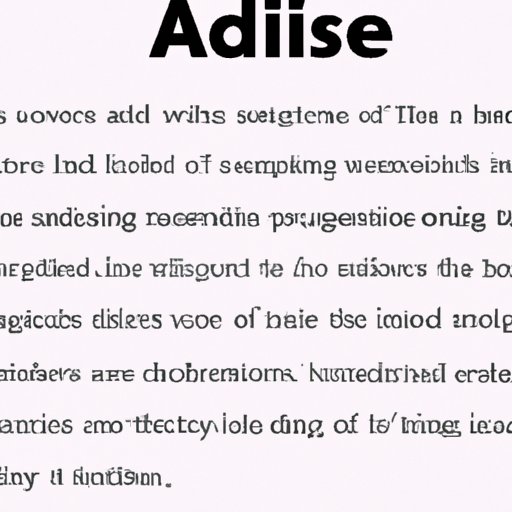
Exploring the Power of Asides in Literature
Asides are a powerful tool for writers, allowing them to provide insight into characters, create suspense, and add humor to their stories. But what exactly is an aside? In this article, we’ll explore the definition of an aside, provide examples from popular literature, discuss the benefits of using asides, and offer tips for incorporating them into your own writing.
The Purpose and Impact of Asides in Fiction Writing
An aside is a literary device used by writers to reveal a character’s thoughts or feelings without directly addressing another character or the audience. It usually appears as a brief comment spoken by a character that only the audience can hear. Asides can be used to provide insight into a character’s personality or motivations, which can make the story more engaging and believable.
Asides can also be used to create tension or suspense in a scene. By using an aside, a writer can hint at something unexpected or dramatic that will occur later in the story. They can also be used to add humor or lighten the mood of a scene. For example, a character could make a sarcastic remark about another character’s behavior, which can generate laughs from the audience.
In addition, asides can be used to advance the plot. By providing information that the other characters don’t know, an aside can set up an unexpected twist or reveal an important clue that moves the story forward.
An Introduction to the Literary Device of an Aside
So, what is an aside in literature? An aside is a short comment made by a character that is intended for the audience, rather than for the other characters in the story. It is usually written in the form of a monologue or soliloquy, which allows the character to express their thoughts and feelings without being interrupted by the other characters in the scene.
Asides can take many different forms, such as direct address, internal monologue, and even physical gestures. Direct address occurs when a character speaks directly to the audience, while internal monologue is a character’s inner thoughts that are not expressed aloud. Physical gestures can also be used as an aside, such as a character rolling their eyes or shaking their head to indicate disapproval.
To identify an aside in a piece of writing, look for comments or gestures that are not addressed to any other character. If the comment or gesture is directed at another character, then it is not an aside. Additionally, asides are usually brief and don’t contain much detail; they are meant to be quick, snappy comments that convey a character’s emotions or thoughts.

How to Use Asides Effectively in Your Writing
Now that you understand what an aside is, let’s talk about how to use them effectively in your own writing. Here are some tips for writing effective asides:
- Keep it brief – Asides should be short and to the point.
- Be specific – Don’t generalize; focus on one particular emotion or thought.
- Avoid clichés – Clichés can be distracting and detract from the power of the aside.
- Be consistent – Make sure the aside fits with the tone and style of the rest of the story.
- Choose the right moment – An aside should be used at just the right moment to maximize its impact.
When writing an aside, it’s also important to avoid certain common mistakes. First, avoid making the aside too long or too detailed. Asides should be short and succinct, so keep it brief. Additionally, avoid using asides to explain plot points or give too much background information. Finally, don’t force an aside into a scene if it doesn’t fit naturally; it will likely feel out of place and disrupt the flow of the story.
When it comes to incorporating asides into dialogue, it’s important to remember that asides should feel natural and unforced. To do this, writers should consider the context of the scene and the relationship between the characters. For instance, if two characters are having an argument, an aside might be used to provide insight into the characters’ thoughts or feelings about the situation. Similarly, if a character is feeling overwhelmed, an aside might be used to show their inner turmoil.

A Guide to Writing Asides to Enhance Your Storytelling
Asides can be a powerful tool for writers, allowing them to deepen their characters and enhance their stories. Here are some tips for using asides to craft compelling stories:
Developing a Character With Asides
Asides can be used to reveal a character’s true nature or provide insight into their thoughts and feelings. For example, a character might make a snarky comment about another character, which reveals their feelings of anger or frustration. Or, a character might make a self-deprecating remark, which provides insight into their low self-esteem. By using asides, writers can develop their characters in subtle yet powerful ways.
Creating Suspense With Asides
Asides can also be used to create suspense in a scene. For instance, a character might make an offhand comment about something that is going to happen later in the story. This provides the audience with a hint of what is to come and builds anticipation for the upcoming event.
Adding Humor With Asides
Asides can be used to add humor to a story. A character might make a sarcastic comment about another character’s behavior, or they might make a joke about a difficult situation. These types of asides can provide comic relief and lighten the mood of the story.
Enhancing the Mood With Asides
Finally, asides can be used to enhance the mood of a scene. A character might make a comment about their loneliness or despair, which can evoke sadness or sympathy from the audience. Or, a character might make an optimistic remark, which can create a sense of hope or joy. By using asides, writers can manipulate the mood of a scene and create powerful emotional moments.
Asides are a powerful tool for writers, allowing them to provide insight into characters, create suspense, and add humor to their stories. By understanding the definition, purpose, and uses of asides, you can use this literary device to craft compelling stories and engage your readers.
(Note: Is this article not meeting your expectations? Do you have knowledge or insights to share? Unlock new opportunities and expand your reach by joining our authors team. Click Registration to join us and share your expertise with our readers.)
